We think the most beautiful aquariums contain brilliant plants. Saltwater and freshwater tanks look amazing when plants and hardscape showcase fabulous fish. All of us aspire to create one of these works of art. Choose gorgeous, helpful plants and your tank is going to look great.

We want to help you choose the best plants. We have compiled a list of the ten best saltwater plants for your next tank project. Each of these plants is both useful and attractive. You can be confident about including them in your designs.
Before we give away our list of the 10 best saltwater aquarium plants, let us talk about why plants are so important for your marine masterpiece.
Contents
- Three Big Reasons to Include Plants
- 10 Most Popular Saltwater Aquarium Plants
- Dragon’s Tongue Algae (Halymenia Dilatata)
- Green Finger Plant (Codium Spongiosum)
- Spaghetti Algae (Chaetomorpha linum)
- Red Mangrove Propagule (Rhizophora Mangle)
- Red Gracilaria Algae
- Halimeda
- Turtle Grass Shoots (Thalassia Testudinum)
- Mermaid’s Fan (Halimeda Udotea)
- Tufted Joint Algae (Cymopolia Barbata)
- Sea Lettuce (Ulva Lactuca)
- How to Choose Saltwater Aquarium Plants
- Care Guide for Beginners
- FAQ
Three Big Reasons to Include Plants
Plants are your partners in the fishkeeping hobby. They fulfill several different roles so you should choose your partners carefully. Wise choices will make your maintenance job easier as well as improving the appearance of your tank.
Plants Eliminate Unwanted Algae
Every aquarium owner hates algae. The green, slimy stuff blocks out light, ruins the views from the tank sides, and can damage fish health. Marine tanks have an advantage in the fight against algae. You can use macroalgae to combat the nuisance algae.
Here’s how macroalgae work for you in a marine tank:
- Microalgae, the slimy green stuff, is made of sheets of little organisms. It feeds on nitrates in the tank.
- Macroalgae, plants you can cultivate, also feeds on nitrates.
- Macroalgae consume much more nitrate than microalgae. They also “feed first” in the food chain.
Since macroalgae feed first, they remove the nitrate the microalgae need to survive. Over time, usually a short period of time, the microalgae starve and die off due to lack of nutrients (nitrates).
The moral of this story is simple: good marine macroalgae can help you avoid bad nuisance microalgae.
Plants Feed Fish
Fish eat plants in the wild. We all know this, of course. But we don’t always think about it as we plan our tank projects. With a little mindfulness, you can help your fish eat a more balanced, natural diet. Simply include some of their favorite underwater salad.
Dragon’s Tongue Algae, for example, is a great source of food for larger herbivorous fish. Many fish will feed on Green Feather Algae as well. You can add many of these plants into your aquarium as a food source for your fish.
Plants Look Great
Reef tanks are at their best when they include different plants because the colors of the plants can add to the overall aesthetic value of the tank. Plants, even algae, come in a wide variety of colors. Their different shapes can also add visual structure and interest to your project.
Stem plants, such as shaving brush plants, mermaid fan, and Halymenia, are great for bringing the planted tank vibe to your marine environment.
Now that we’ve mentioned a few reasons to add plants into your reef, let’s look at which ones you could choose.
10 Most Popular Saltwater Aquarium Plants
All the plants we are going to list for you will be great additions to your reef setup. You won’t choose every one of them – you might run out of space! We’re sure you can find several to help your tank look and live better.
Dragon’s Tongue Algae (Halymenia Dilatata)
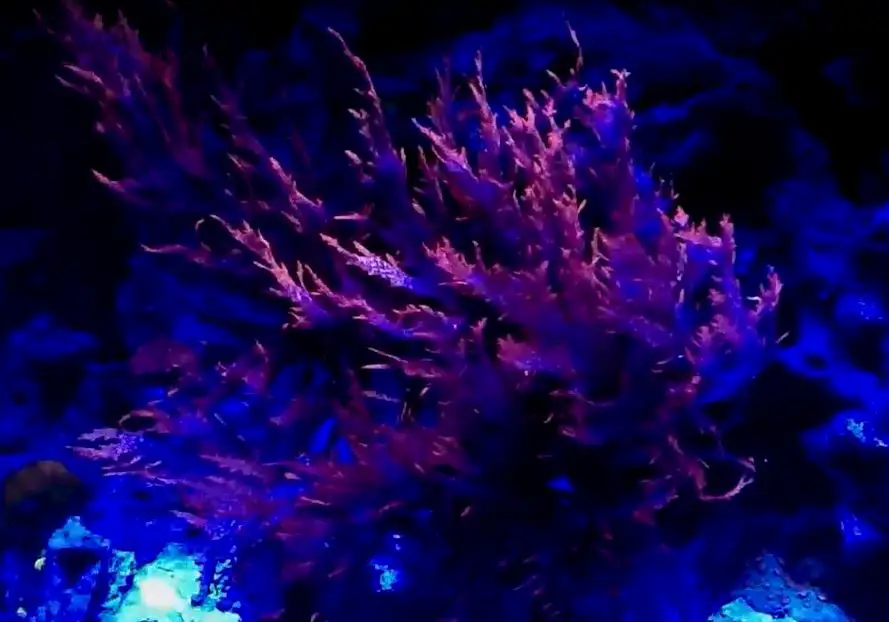
Drop an immediate visual highlight into your tank with the Dragon’s Tongue Algae. Dragon’s Tongue has a beautiful, deep red color. The fronds are very distinct and can either form a small shrub or a more flowing tree-like shape.
Dragon’s Tongue grows fast and is suitable for a wide variety of marine tank conditions. The only thing to consider is the pairing of Halymenia with larger herbivorous fish. Some species of fish will eat these gorgeous plants.
Green Finger Plant (Codium Spongiosum)
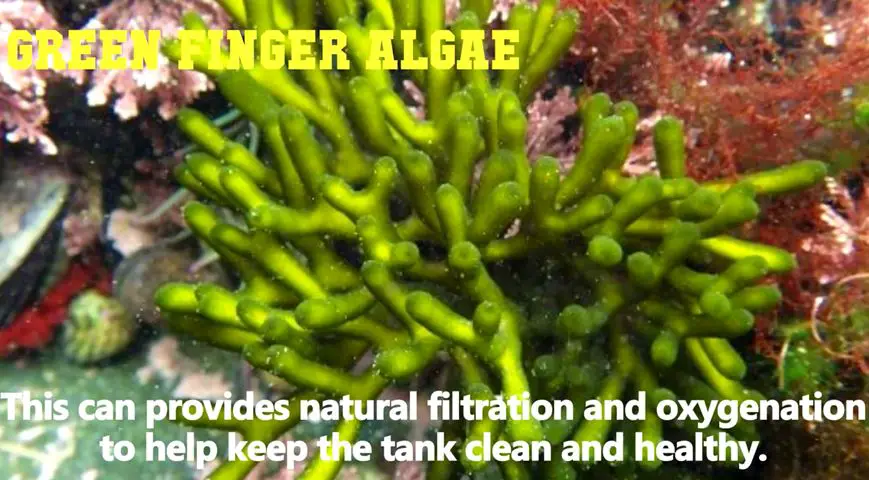
Most fish will stay away from this lovely green macroalgae. The Green Finger Plant grows like its name suggests. Small ‘fingers’ poke up from a central area. These can look like little fingers or even like the antlers on a deer.
Green Finger Plants provide the natural filtration and oxygenation needed to help keep your tank looking fresh and beautiful. It will grow fast under the right conditions. However, its preferred temperature is between 72-78° Fahrenheit (22-25oC). This may be a little cooler than some fish prefer.
Spaghetti Algae (Chaetomorpha linum)
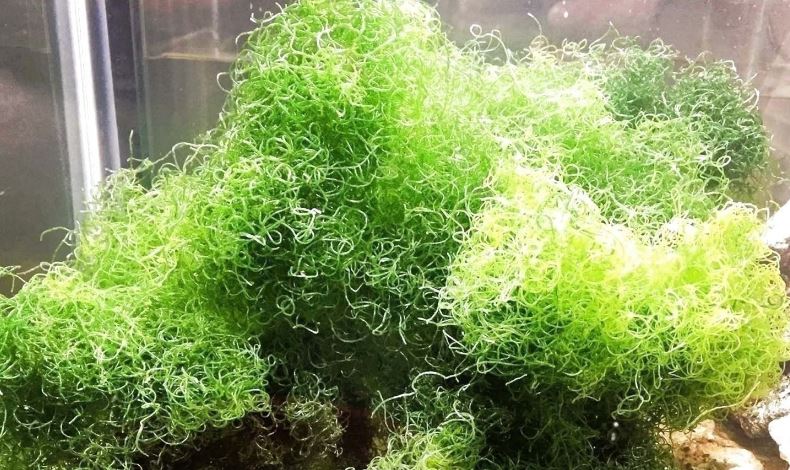
Spaghetti Algae is a useful control plant in marine tanks. Its ability to absorb nitrates and release oxygen makes it helpful for balancing the ammonia cycle. Spaghetti Algae also work to buffer pH levels. The tangled leaves form hiding places for little creatures. Finally, most fish don’t eat this plant so it should thrive in the right conditions.
Spaghetti Algae can grow in different ways. Many people attach it to rocks but it can grow freely and float in the tank. The filaments can grow to as long as 7-8” in length.
Red Mangrove Propagule (Rhizophora Mangle)
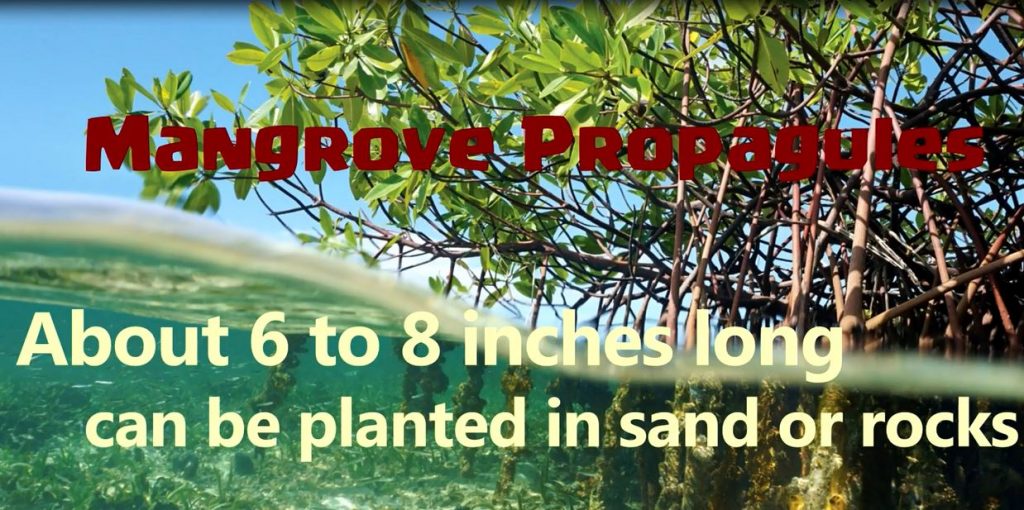
Mangroves can make a fantastic addition to your reef tank because of their visual appeal. Their long trunks can reach from the depths of your tank up to the surface. Above the surface, the broad, vivid green leaves can add height to your aquatic space. Grown in groups, these tall plants can form the appearance of a bamboo forest in your tank.
Quality mangroves are sold as propagules. These look a little like tubers, but they are the best choice for propagation in your tank. The leaves need to be above water and the roots will quickly anchor into sand or live rock.
Red Gracilaria Algae
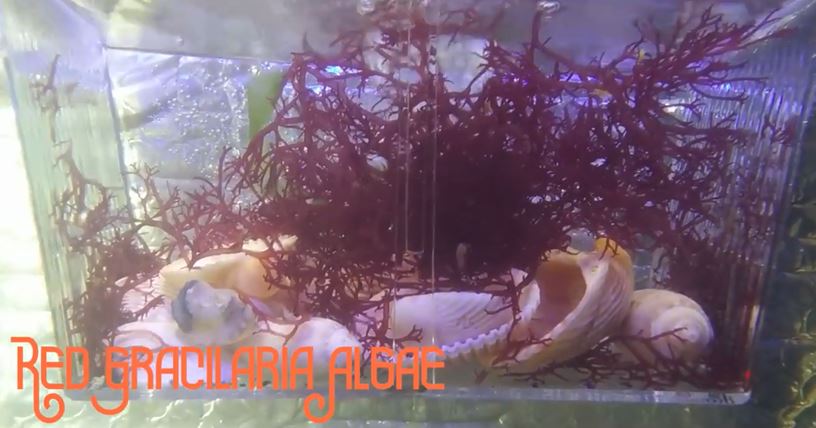
Gracilaria is another useful macroalgae to include in your tank. Many hobbyists grow gracilaria in a refugium but its use as a display species is increasing. Gracilaria is a seaweed and excels at cleaning the water.
Red Ogo Gracilaria is a red species with this genus. It is attractive but also beneficial as a food source for your fish. Gracilaria Pacifica is another species that grows inside the tank and resembles a burning red fan. You can find even more species of this useful algae to suit your needs and tank appearance.
Halimeda

Halimeda is a unique alga. Its cell structure is different because each of its segments is one large cell with multiple nuclei. Segments grow one after another, connected by a small strand. Specimens have been found at great depths, so its adaptability is very high.
Halimeda Tuna and Halimeda Opuntia are both species used in the reef tank hobby. They can grow attached to the reef bottom or to live rock. Halimeda algae absorb high levels of calcium. Their willingness to grow is a good indicator of a sufficient level of calcium to support coral growth.
Turtle Grass Shoots (Thalassia Testudinum)
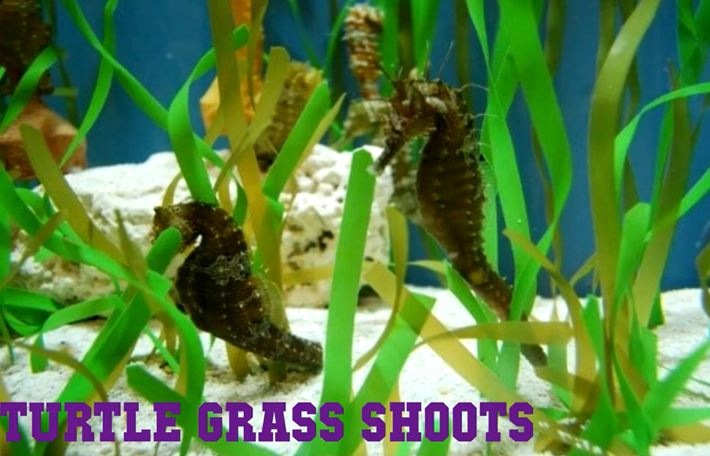
Turtle Grass is a seaweed and macroalgae that you can use to carpet the bottom of your tank. A few extra things must be added to take care of this plant, though. Turtle Grass requires lots of light and water flow. Its native area is the Florida Gulf coast. Recreating these conditions in your tank might not be easy.
For those who persevere, the result will be a remarkably attractive plant. It can be used in groups to create a natural-looking sandy bottom to your marine tank.
Mermaid’s Fan (Halimeda Udotea)

Another species in the Halimeda genus is the Mermaid’s Fan plant. Reef tanks will benefit from this plant’s unique features. It grows as a single broad leaf, resembling a fan. Bright green in color, the mermaid’s fan is a great visual point in a display tank.
Care for this plant is simple. Most fish will not eat it because the leaves are too full of calcium. Extra light may be needed to help this plant’s growth. High levels of nitrate or phosphate can make it difficult for Mermaid’s Fan to thrive so these levels should be monitored.
Tufted Joint Algae (Cymopolia Barbata)
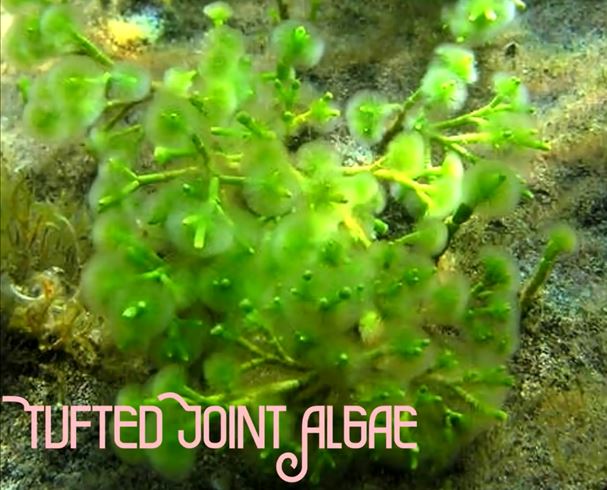
Few marine plants are quite as striking as the Tufted Joint Algae. This little green beauty grows like a small tree. Each trunk is made of small segments. At the end of each trunk, small hairs erupt outwards in a tiny explosion of verdant green.
Tufted Joint Algae can be used as a display plant and is usually mounted on a piece of live rock. Keepers of tangs and angels can consider keeping this macroalga in a refugium. Clippings can be fed to the fish as a dietary supplement.
Sea Lettuce (Ulva Lactuca)
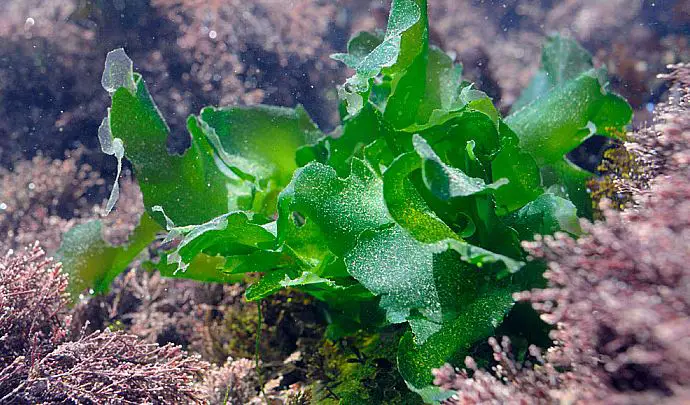
Last on our list is one more super helpful plant. Sea Lettuce is not the most slightly of plants, but its beauty comes from its growth. It grows really fast! This solves one dilemma most tank owners have: keeping the levels of nitrates and phosphates low.
Sea Lettuce is ideal for a brightly lit refugium with high flow. It will reproduce and grow very quickly. Clippings can be fed to many herbivorous fish. Right away, this helpful macroalgae will begin to balance your tank’s nutrient levels.
How to Choose Saltwater Aquarium Plants
Choosing the correct plant for your tank is not a difficult exercise. There are a few things to consider, though. Here are a few questions to help you make a great choice:
- What do you want the plant to do? Display plants can be chosen for their color, size, and preferred location in the tank. ‘Working’ plants can be used to reduce nitrate levels, buffer the pH in a tank, or provide extra food. Once you settle on the purpose of the plant, a few species will become obvious.
- What features are most important? If you are trying to create a specific look in your tank, then choose plants matching your aesthetic. Lighting level, flow rate, and fish compatibility will all affect your choice.
- Do you have the necessary conditions to help the plant grow? Plants thrive with different conditions. You might really like the look of some plants. However, if you can’t keep them alive then they will become a disappointing nuisance for you. On the other hand, if one plant really catches your eye, then you can build your tank’s setup around that plant’s needs.
Wikipedia has a great list of aquatic plants.You can start there to learn the basics about the right conditions for macroalgae to thrive.
In addition to all these points, think about your fish. If your plants are going to be in a tank with fish, then you should take care to make them match. Lighting, flow, and water parameters all need to be compatible.
Care Guide for Beginners
There are a few things to do for your plants. If you stay on top of these things, you will find plants grow easily in your tank. Here are the three most important:
- Get your lighting correct. Macroalgae require light to grow. Many species, especially the greens, need a lot of light to grow. If your aquarium isn’t lit well, then your plants will struggle. Likewise, red algae need a little less light. You can place it in the shady parts of your tank or just use less light.
- Monitor your nutrient levels. Plants grow with nitrates and phosphates. They also need iron. Species of macroalgae frequently need calcium as a trace nutrient. If you monitor your nutrient levels and adjust your dosing accordingly, your plants will thrive.
- Control their growth. Macroalgae can grow very fast and overtake other plants and corals in your tank. If you trim them regularly, then you will have an attractive, natural-looking tank.
FAQ
Is coral a plant?

No, coral is not a plant. Corals are actually animals. Each coral mound is made of thousands and thousands of tiny invertebrates. These are called coral polyps. Each polyp can grow fairly large, but most of the size of corals comes from the high numbers of polyps growing together.
Are algae a plant or protist?
Algae are plant-like protists. They have some features of plants, such as chlorophyll and the use of photosynthesis. Yet they lack other plant features such as roots, stems, and leaves. Algae can be single-celled or multicellular.


